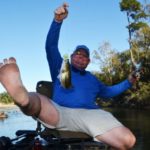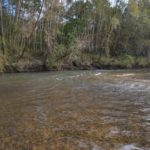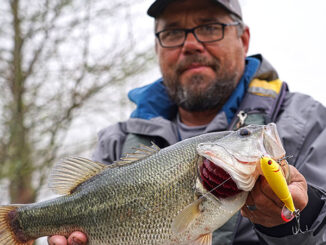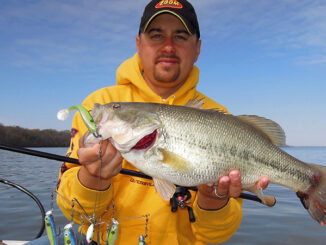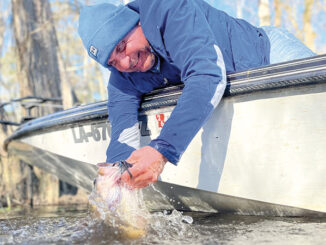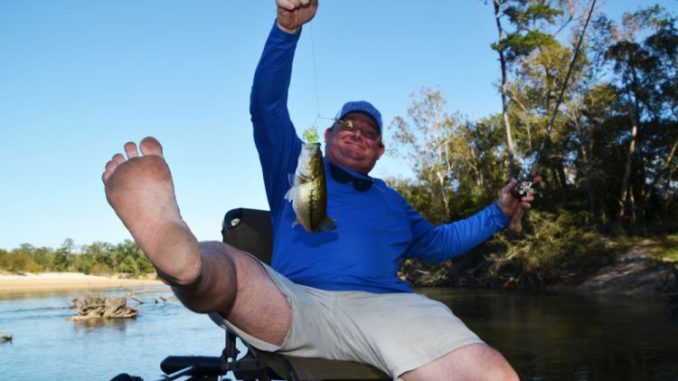
The scenic, fast-flowing Bogue Chitto is a shallow, clear-water gem that’s home to some Kentucky bass with big attitudes. Here’s how a couple of local anglers with a specially-equipped boat run the river.
“Ya ever been on the river before?” drawled the laconic 48-year-old.
“Nah,” I had to answer.
“Well, welcome to shallow,” he grinned — just barely.
The “river” he was talking about was the Bogue Chitto. Located in Washington Parish (where the toenail would be in Louisiana’s boot shape), it arises near Brookhaven, Mississippi, flows south to the Mississippi-Louisiana state line, then cuts diagonally southeast across the parish to its confluence with the Pearl.
This adventure had started a couple of weeks earlier, when I pulled into the Market Max service station in Franklinton. As I gassed up my charger, a truck pulling a really odd-looking boat pulled to the other side of the pump island.
The heavily reinforced 16-foot aluminum flatboat sported an elevated transom that was 3 feet higher than the boat’s gunnels. It made the 115 Yamaha mounted on it tower over the boat’s owner, Todd McElveen, when he stood beside it.
I walked around the back of the boat and wow — no prop. It looked like someone had stolen the whole lower unit.
And to top off the bizarre look, the trolling motor on the bow deck was installed with huge springs, rather than hard-mounted.
I couldn’t help myself. So I walked up to the stranger and asked him something along the lines of “What is it?” Fortunately, he was very cordial — and patient.
“It’s my river boat. I use it to fish in the river,” he said, waving one hand vaguely in the Bogue Chitto’s direction. “We catch a lot of Kentuckys” — the local name for spotted bass.
Now he really had my attention.
“You want to see it run?” he cordially asked me. “We’ll go when the river goes down and clears up.”
Fast-paced fishing
I quickly realized the perspective from actually being on the river rather than viewing it from a crossing bridge was significantly different. From a bridge, it’s just a shallow, clear-water river.
Only at river level can one appreciate the velocity of the flow, sucking noisily at stumps and snags lying in its bed. Although patches of sand exist, most of the Bogue Chitto’s bed is paved with gravel.
If one is quiet in a swift-flowing spot, the sound of gravel clinking along the bottom is clearly audible. It isn’t exactly what tourism brochures would depict as being part of the “Bayou State.”
Along for the trip with McElveen, a retired law enforcement officer, was 45-year-old Steven Schilling, a wholesale/retail crawfish dealer based out of Clifton, a tiny community in rural Washington Parish.
In contrast to McElveen’s stoic demeanor, Schilling’s perpetually grinning and animated face made him seem like someone who could turn a funeral into a party. Both men are fanatical hunters and fishermen, and both share a deep love for their river.
Running the Bogue Chitto in a jet boat was an experience.
Seeing the rocky bottom below, in 3 inches of water, was amazing. Popping over a big log lying across the channel 2 inches underwater was disconcerting to someone used to running a prop boat, and I fully expected the lower unit to crash into the log the next second.
When they reached their spots (all below the Highway 16 Bridge in Franklinton), they did their fishing by floating downstream until they got antsy and moved to another stretch.
At the first stop, McElveen gave instructions.
“You see how swift this river is? We are going to bump into a lot of stuff,” he cautioned. “We try to warn each other when one of us sees a bump coming. I don’t know if there’s a trolling motor made that is strong enough to give complete control.”
“But there’s some real good fishing here,” added Schilling enthusiastically. “You got to find their pattern. Sometimes they’ll be behind the logs and stumps in the middle of the river. Sometimes they will be beside them.
“You’ll catch some fish in the quieter, deeper water near cut banks, but the best places for Kentuckys are swifter water.”
“But you see that?” interjected McElveen dryly, while pointing at a sand and gravel bar on one bank. “Don’t cast there. That bare bank is a wasted cast.”
It was fast-paced fishing, the boat drifting end around end, even with McElveen on the trolling motor, generally keeping the boat in functional fishing position. Half the time, the boat drifted stern first; half the time, bow first.
Sometimes it drifted into massive tangles of willow treetops hanging low over the water. Between and during casts, they often used their feet and hands to fend the boat off logs and stumps.
But the fishing action was worth it. One or the other always seemed to be yanking a stubborn spotted bass out of a dark water pocket next to something woody.
Some of the casts were long, but many, by necessity, were 10-foot flip casts made on a split-second opportunity. The fish were aggressive, so the boat being close didn’t seem to matter.
The visual aspect was spectacular, especially with a spinner bait. You could actually see the fish hit the bait a split second before you felt it.
“That’s a lot of fun,” chuckled McElveen, “but you can’t always count on seeing the fish. Sometimes, one will come out of nowhere to hit your bait in 2 inches of water.”
